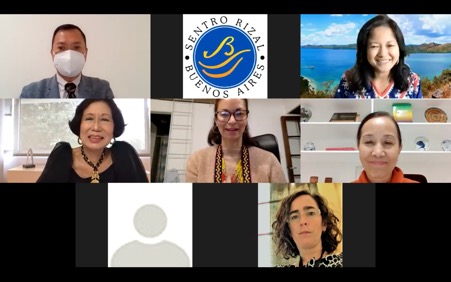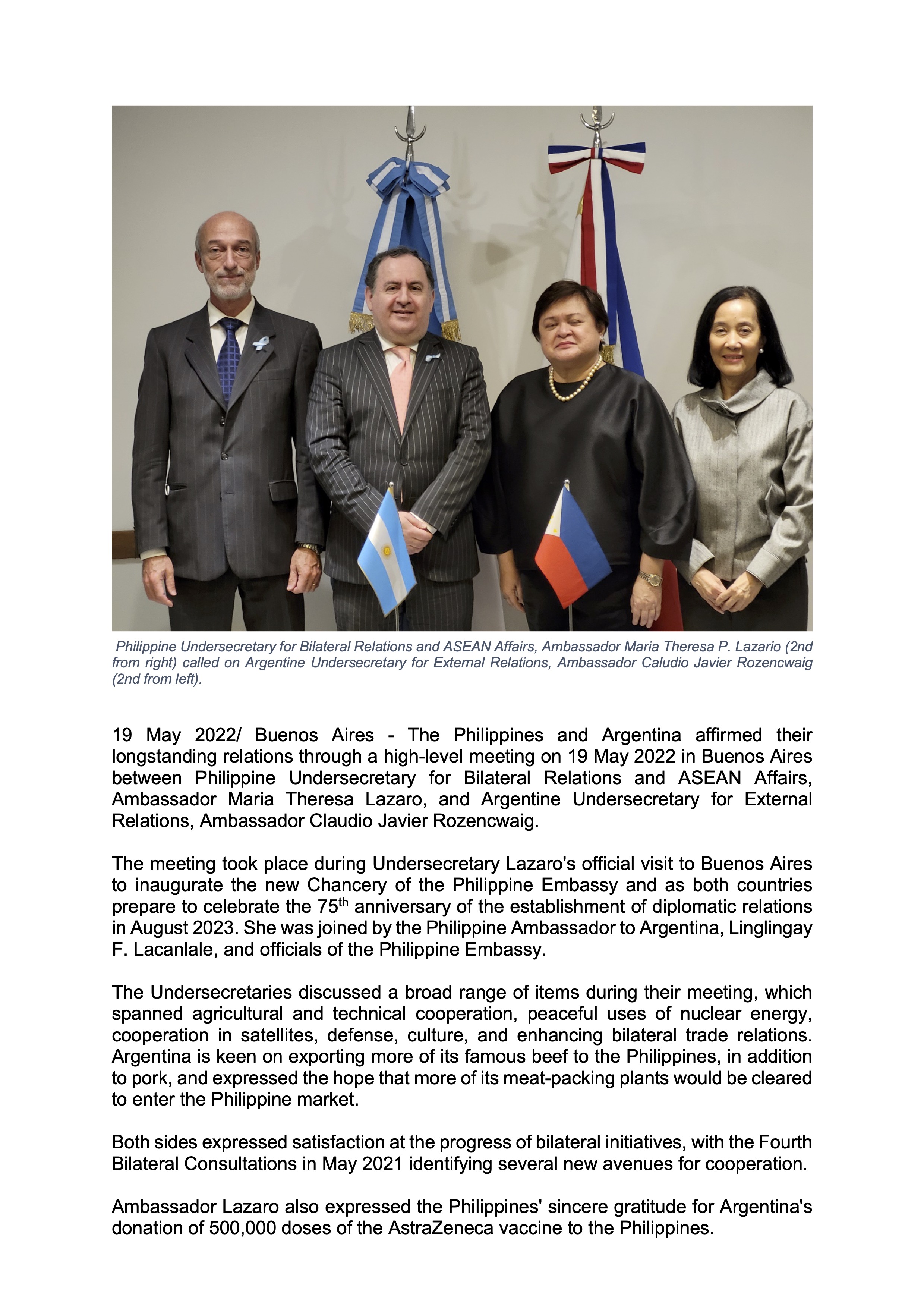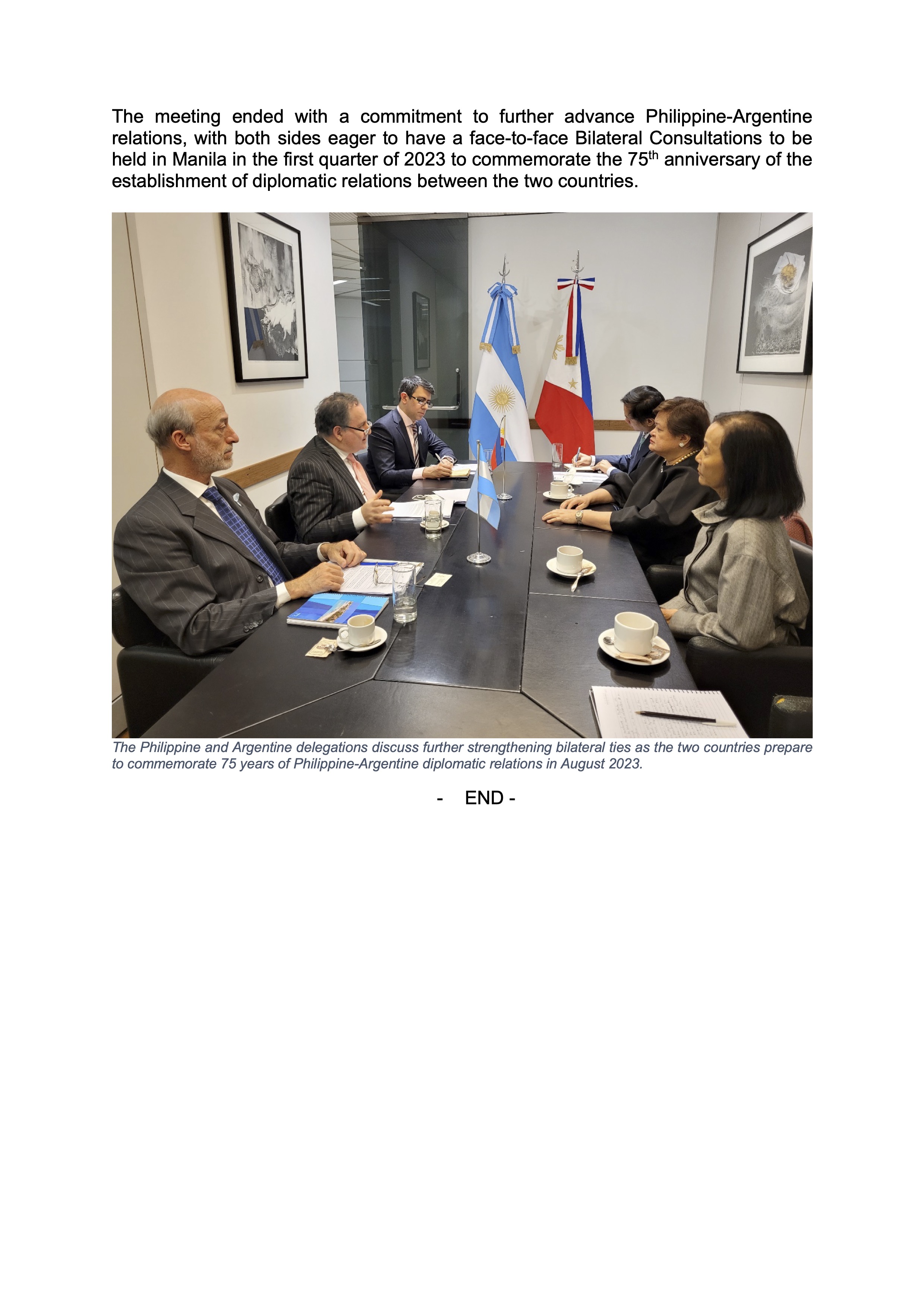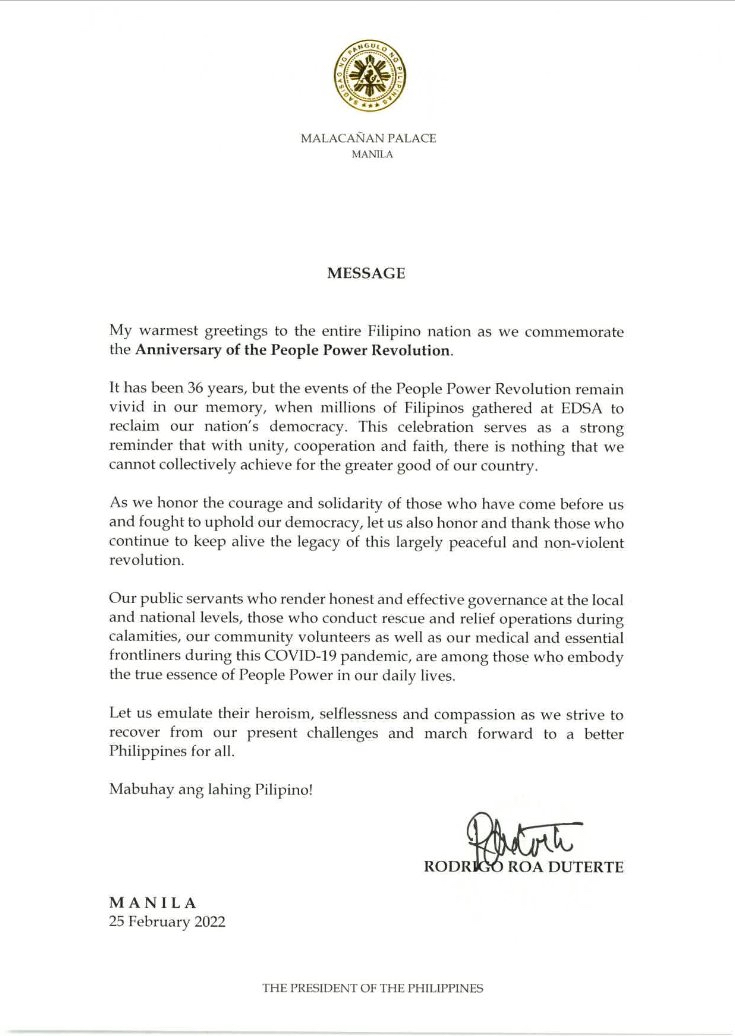Bienvenidos
La Embajada de la República de Filipinas en Buenos Aires se encarga de promover y proteger los intereses de Filipinas y el bienestar de los ciudadanos Filipinos en Argentina, Bolivia, Paraguay y Uruguay.
¿Quisiera saber más sobre las actividades de la Embajada?
¿Quisiera hacer negocios con Filipinas?
EMBASSY NEWS
- Tuesday, 30 July 2024 Foreign Ministers Support PH, China's De-Escalation Efforts in the South China Sea
- Tuesday, 30 July 2024 DFA Spokesperson´s Response to the MFA Spokesperson´s Statement Regarding the 27 July 2024 RORE Mission in Ayungin Shoal
- Tuesday, 28 May 2024 DFA Statement of the New China Coast Guard Regulations
- Tuesday, 28 May 2024 DFA Statement on the Advisory Opinion of the International Tribunal of the Law of the Sea (ITLOS) on the Request Submitted by the Commission of Small Island States on Climate Change and International Law (Case No. 31)
- Tuesday, 28 May 2024 Press Release on China´s Fishing Moratorium Over the South China Sea
ANNOUNCEMENTS
- Thursday, 24 October 2024 Request for Quotation - For the Procurement of a Passenger Van (Non-Luxury) for the Philippine Embassy in Buenos Aires 2024
- Thursday, 10 October 2024 Notice of RERB Hearing - 21 October 2024
- Tuesday, 02 July 2024 Notice of RERB Hearing - July 2024
- Tuesday, 04 June 2024 Request for Quotation - For the Procurement of a Passenger Van (Non-Luxury) for the Philippine Embassy in Buenos Aires 2024
- Wednesday, 03 April 2024 Notice of RERB Hearing Cancellation April 2024
Philippines and Paraguay hold historic first high-level trade meeting
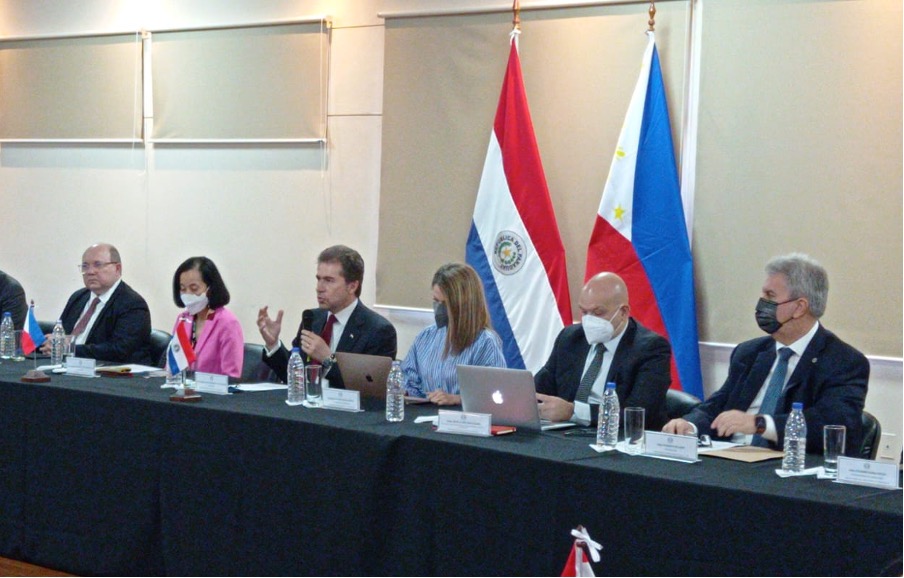
Paraguayan Industry and Commerce Minister Luis Castiglioni (3rd from left) and Ambassador Linglingay Lacanlale (2nd from left) led the first Philippines-Paraguay Trade Meeting held in Asuncion, Paraguay, on 14 March 2022.
Asunción, Paraguay/ 14 March 202 – The Philippines and Paraguay, two countries with deep historical bonds, moved a step closer to strengthening their trade and commercial ties by holding the first high-level meeting on trade between the two countries in Asunción, Paraguay on 14 March 2022.
The Official Mission of the Philippines, led by Her Excellency Linglingay F. Lacanlale, Philippine Ambassador to Argentine who has concurrent nonresident jurisdiction over Paraguay, and Mr. Vichael Roaring, Commercial Counsellor for Latin America of the Philippine Trade and Investment Center (PITC)-Mexico, met officials of the Paraguayan Ministry of Industry and Commerce, led by Minister Luis Alberto Castiglioni and the Investment and Export Network (REDIEX) of Paraguay, led by Vice-Minister Estefanía Laterza.
With the aim of deepening commercial ties and business opportunities between the two nations, the two sides agreed to conduct the meeting through the Philippine Embassy in Argentina and the Office of the Commercial Counsellor of Paraguay in Argentina.
In her remarks, Ambassador Lacanlale encouraged Paraguay to explore the possibility of using the Philippines as its entry point to the greater market of the Association of Southeast Asian Nations (ASEAN) and also to look into the country as a viable market for Paraguayan goods.
"The Philippines was one of the fastest-growing economies in the world before the pandemic. Our country is now on the road to recovery. Our global growth in 2021 was 5.6%, and the economy is expected to grow by 9% this year. Our trade relations with Paraguay have remained stable but modest in the last four years. We need to do more to expand our cooperation economy," remarked the Ambassador.
For his part, Minister Castiglioni expressed hope that this meeting could generate conditions for a stronger economic and commercial exchange between the Philippines and Paraguay in the near future.
"We hope to have economic and commercial missions from Paraguay to the Philippines and vice versa soon. We, in the public sector, always work very closely with our private sector," the Minister stressed.
The meeting was attended by the movers and shakers of the Paraguayan economy. Minister Castiglioni said that 75% of Paraguay's gross domestic production (GDP) was present during the meeting.
Representatives of the different unions and chambers in Paraguay, namely, the Paraguayan Industrial Union (UIP), UIP Joven, Paraguayan Chamber of Rice Industrialists (CAPARROZ), Chamber of Paraguayan Food Companies (CAPALI), Paraguayan Chamber of Oilseed Processors and Cereals (CAPPRO), Paraguayan Meat Chamber (CPC), Paraguayan Yerba mate Center, beef, poultry and pork slaughterhouses, attended the meeting.
Many of those present in the meeting noted that complementarities between the Philippine and Paraguayan economies exist that both parties could take advantage of. They also noted that the ongoing geopolitical crisis in Ukraine opens up possibilities for the two countries to diversify their respective supply chains and create new opportunities for trade with non-traditional partners.
END
PHILIPPINE EMBASSY IN ARGENTINA PROMOTES PHILIPPINE CUISINE VIA A WEBINAR ON THE SPANISH INFLUENCE ON FILIPINO FOOD
Buenos Aires/ 9 September 2021 - There are many ways to make adobo. Widely considered the quintessential Filipino dish, it is said that each province has its own version of making it. One of the more popular takes on adobo prescribes the use of laurel leaf, an herb that is native to theMediterranean, but not the Philippines. The very word adobo comes from Spanish. Why, then, is it so representative of the Philippines?
This was one of the questions tackled by food historian Felice Prudente Sta. Maria in her talk entitled “Tiene un nombre espanol pero tiene un sabor filipino”, held on 9 September 2021. Organized by the Sentro Rizal of the Philippine Embassy in Buenos Aires, in cooperation with the National Commission for Culture and the Arts (NCCA) and the Department of Tourism (DOT)-Los Angeles (USA), the conference sought to trace the curious evolution of Filipino cuisine and its links with Spain and Latin America, drawing on the participation of food historians and gourmands from the Philippines and Argentina
Ms. Sta. Maria describes the encounter between Filipino cuisine with materials and techniques from Spain and Latin America as an irreversible event. Through the Manila–Acapulco galleon trade known as the La Nao de China in Latin America, Spain introduced various fruits and vegetables that would form an indispensable part of our diet. The popular nursery rhyme, Bahay Kubo, taught universally to pre-school Filipino children, is also a catalogue of fruits and vegetables originally from Mexico.
Spain also introduced the concept of the guisado, another essential hallmark of Filipino cooking, which has greatly enriched Filipino cuisine’s flavor base. Meanwhile, the introduction of wheat led to more exposure to European baking traditions, and the rise of bakeries and Filipino pastries.
This encounter was not a one-sided event. The galleon trade also brought Filipino settlers and traditions to Latin America, principally Mexico, where they introduced the fermentation of coconut wine tuba, which is known as tuba fresca in Mexico and is still popularly consumed there.
Among the more talked-about ideas proposed in recent years holds that Peruano ceviche traces its genealogy to kinilaw, which, more than a mere name of a dish, is technique thought to be at least a thousand years old. Chicken also came to Latin America by way of the Spanish maritime trade route.
In the case of adobo, the technique of cooking meat or fish in vinegar is certainly indigenous to the Philippines. However, the base recipe has evolved over time to embrace various ingredients and permutations, making it truly authentic and innovative at the same time. It owes its present name to Spanish attempts to describe its salty, tangy flavor profile.
Any discussion on Filipino food would be remiss without tackling its social function. According to Ms. Sta. Maria, the Filipino context of eating is always communal, serving to reinforce interpersonal bonds.
To complement the lecture by Ms. Sta. Maria, Buenos Aires-based chef Christina Sunae, owner of two popular restaurants in Argentina serving Filipino food Apu Nena and Cantina Sunae, shared her experiences in writing her book, Kusinera Filipina. The book, realized in tandem with the Philippine Embassy in Argentina, is the first Filipino cookbook written entirely in Spanish. Chef Sunae described the many parallels between Filipino and Latin American cuisine, remarking on the similarities in taste, as well as their respective social contexts. In the Philippines, as in Latin America, food is enjoyed within social groups, and not simply eaten.
Philippine Ambassador to Argentina, Linglingay F. Lacanlale, remarked on the diverse and often surprising links between Filipino and Latin American cuisines. She expressed hope that the webinar might serve as a bridge for deeper understanding and appreciation of our culinary traditions and their truly global heritage.
END
